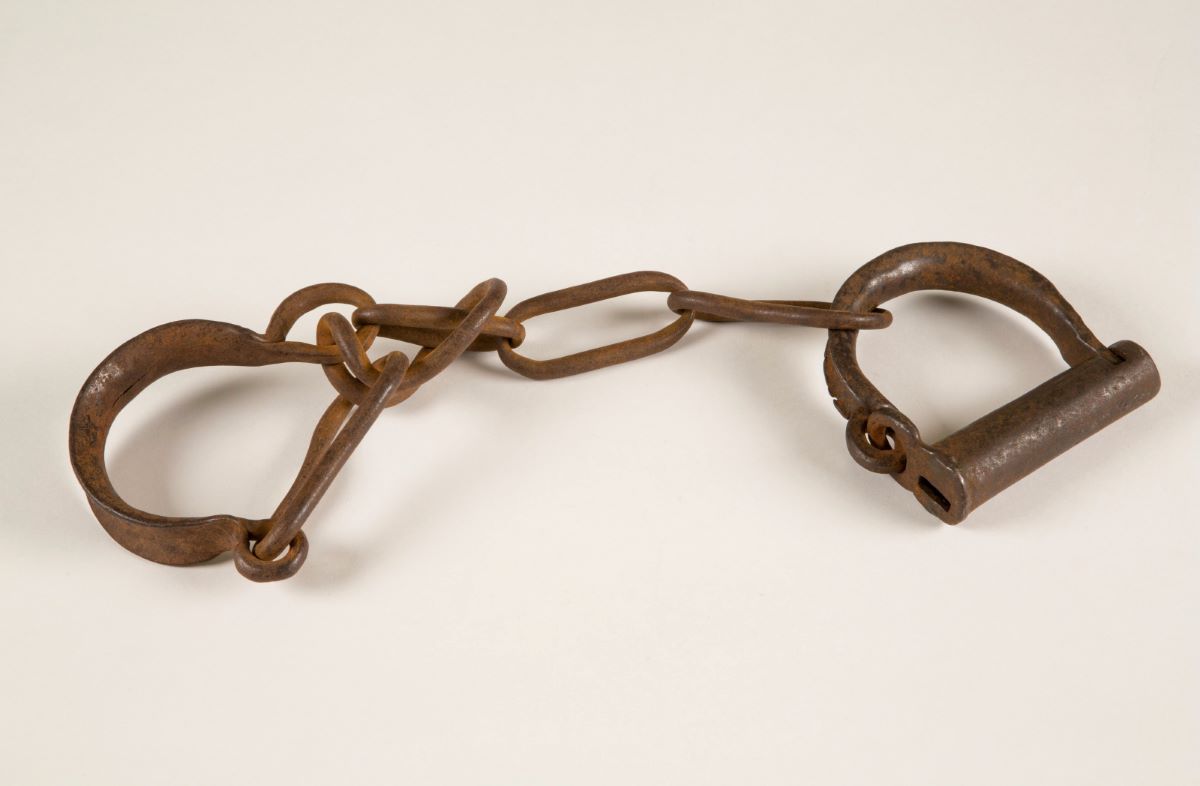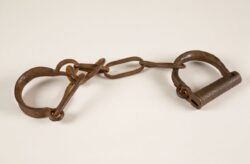Revolt Aboard the Ship Creole
The rebellion of enslaved people aboard the ship Creole resulted in the self-liberation of more than 120 people.

The Historic New Orleans Collection
Iron restraints were commonly used on the hands and feet of enslaved people being moved in the international and domestic slave trades.
The Creole revolt was a successful shipboard revolt of enslaved people in November 1841. The Creole’s crew was piloting the ship from Norfolk, Virginia, to New Orleans as part of the United States’s domestic slave trade. Off the coast of Florida in the Atlantic Ocean, nineteen enslaved people gained control of the ship. Led by Virginian Madison Washington, the rebels demanded that the ship be navigated toward Nassau, the capital of the United Kingdom’s colony, the Bahamas. The rebels figured that they had a good chance of becoming free in the Bahamas for two reasons: the British had abolished slavery in their western hemisphere colonies in 1834, and the British had liberated enslaved people aboard a similar ship, the Hermosa, when it ran aground in the Bahamas in 1840. Their reasoning proved correct, and the British allowed most of the enslaved people aboard the Creole to leave the ship despite attempts by the American consul in the Bahamas to prevent their liberation. Black Bahamians—most of whom had become free as the United Kingdom phased out slavery in its Caribbean colonies from 1834 to 1838—had also boarded small boats, surrounded the Creole, and kept watch over the ship while it was in the harbor. The rebels who took control of the ship waited aboard and were imprisoned until British authorities cleared the surviving seventeen rebels (two died either during the revolt or in British custody) of any wrongdoing in early 1842.
The Creole exacerbated tensions between Great Britain and the United States. The two countries were already at loggerheads over issues related to the US-Canadian border and British efforts to police the international slave trade. From the American perspective British authorities in the Bahamas had interfered with American property on an American ship, which was a significant breach of sovereignty. While some southern senators called for war, some northern members of Congress supported the British actions. The British dispatched a special diplomatic mission to Washington, DC, to ease tensions, culminating in the Webster-Ashburton Treaty (1842). Though the treaty solved many pre-existing problems between the United States and Great Britain, the two countries found no solution regarding the Creole. The United States demanded compensation for the enslaved people liberated by the British. Still, the British only guaranteed that they would instruct their governors in the Caribbean to obey American laws on American ships, if possible. It took a special treaty to finally resolve the diplomatic matter, when, in 1853, the British agreed to compensate American enslavers for the people liberated aboard the Creole and other similar ships.
As the diplomatic controversy played out in Washington and London, enslavers who lost their human property aboard the Creole sued insurance companies in New Orleans. It was common for slave traders to insure their human cargo to hedge against financial losses that might occur during the risky maritime passage to New Orleans. When the companies that insured the Creole’s cargo denied enslavers’ claims, lawsuits ensued. Because of the nature of the insurance contracts, the case pivoted on the cause of the loss of the enslavers’ property—in particular, whether the enslaved became free because of British interference or because they rebelled. The insurance policies covered losses by external actors—pirates or foreign powers—but not losses caused by rebellion. The Louisiana Supreme Court provided the final ruling in 1845, delivering a victory to insurance companies. Their legal team, headed by Judah Benjamin and Thomas Slidell, convinced the court that the rebellion aboard the ship was the critical moment of financial loss rather than any action or inaction of British officials.
While the diplomatic and legal stories progressed in the United States, the victorious rebels adjusted to life as free subjects of the British crown. Some boarded ships to Jamaica, but many remained in the Bahamas. For instance, Elijah Morris, one of the rebellion’s leaders, purchased land in the Bahamian village of Gambier and raised a family there. Gambier was one of many villages that Africans created in the Caribbean during the first half of the nineteenth century after being liberated from transatlantic slave ships by the British Navy. In other words, many of Morris’s neighbors survived slavery at sea, just like Morris.
The rebellion aboard the Creole was one of a few successful shipboard slave rebellions during the era of the United States’s domestic slave trade. It enflamed tensions between the United States and Great Britain, caused years of lawsuits between enslavers and insurance companies, and resulted in the self-liberation of about 128 people. The Creole rebellion serves as a stark reminder that enslaved people resisted the slave trade and slavery, and when opportunity struck, made themselves free.
